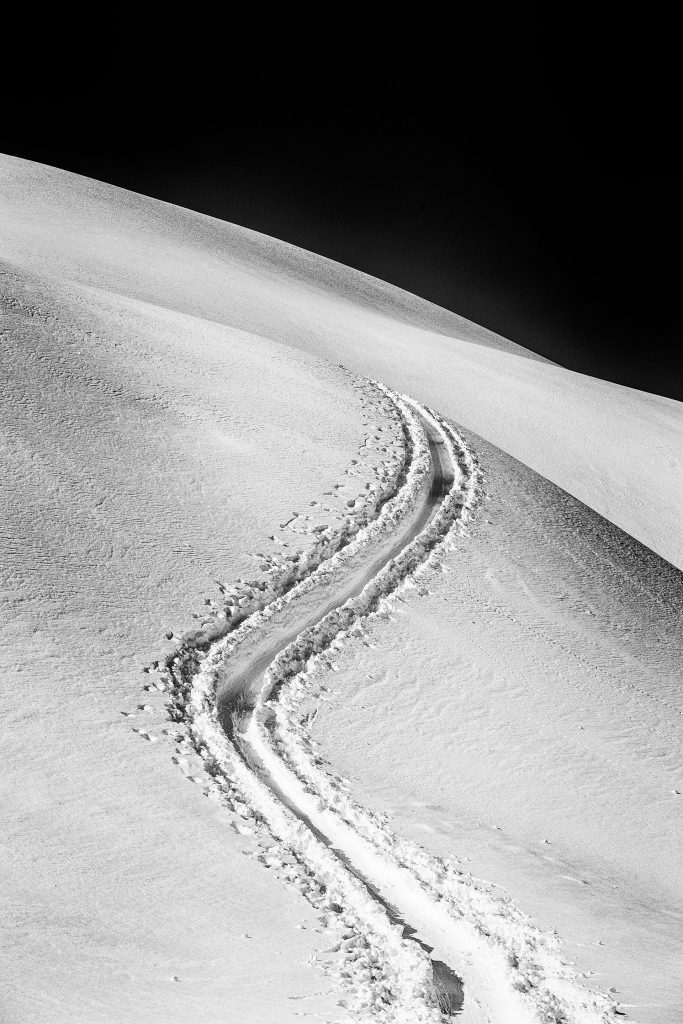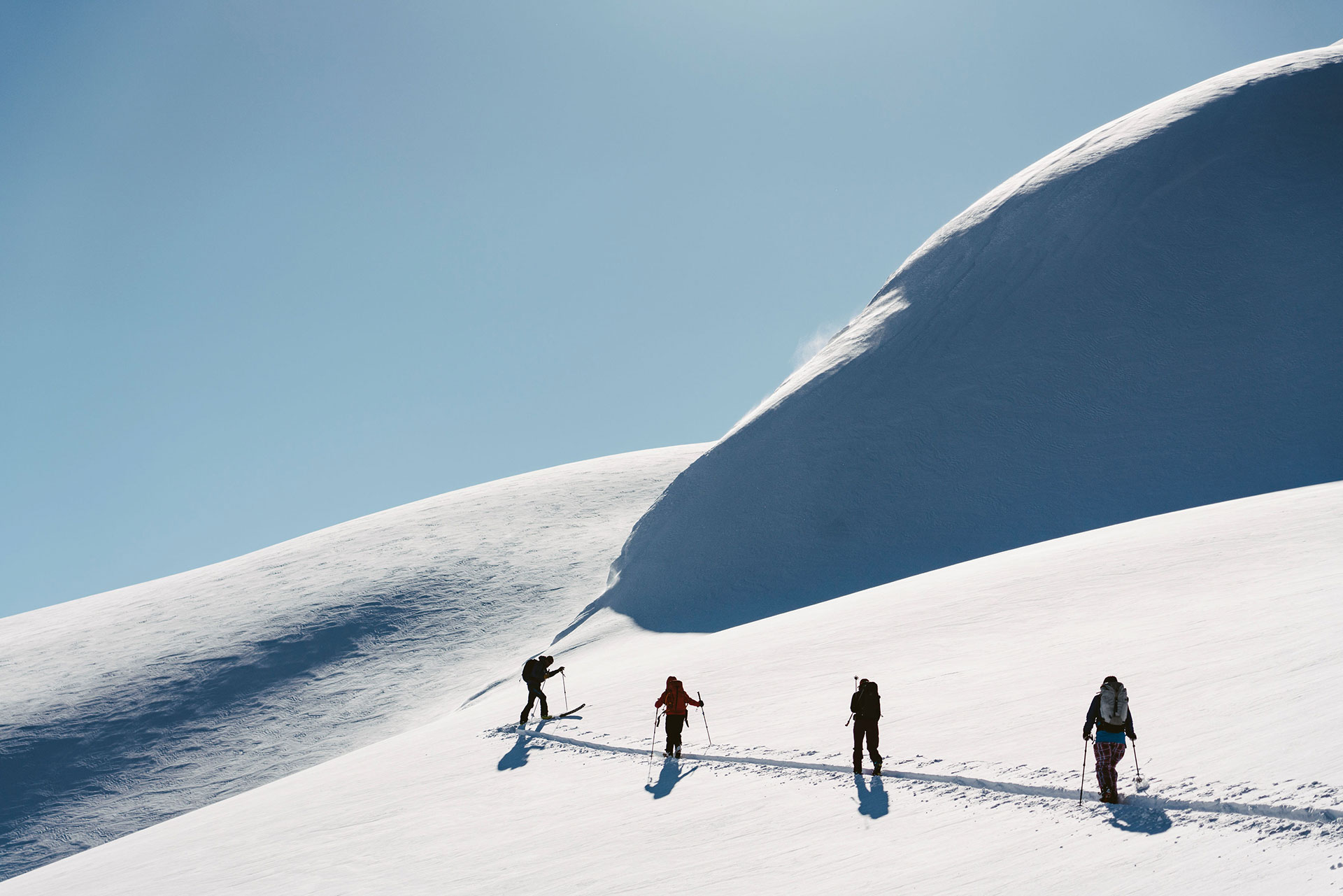How To Set a Skin Track
Backcountry tourers describe tracksetting as setting an uphill track to a pass, summit, or top of the ski run. Usually the person in front sets the track and establishes a comfortable route uphill for those in their party—and for parties trailing behind—to follow. Trailbreaking, or setting the track in fresh snow, is often synonymous with tracksetting.
I personally like to differentiate between the terms trailbreaking and tracksetting. Too many times I’ve seen the former action as crushing snow indiscriminately with little regard to efficiency or comfort. To me, tracksetting infers an intent to select where the track goes, and to artfully determine how it goes there. Visually, a well-set track winds elegantly uphill. Physically, a well-set track gains elevation comfortably and climbs from the bottom to the top of the run without draining my physical reserves. I call this “intentional tracksetting.”
Over my guiding career I have had the honor to mentor a number of guides as they worked through their apprenticeship. It’s always been a challenge to convey this notion of intentional tracksetting in a manner that aspiring guides could apply in the field.
The obvious method of practice is to follow and analyze a well-set track, then retreat and set your own. I realized that whenever I followed another person’s uphill track, I would ask myself, “Why did they turn where they did?” I know the goal is to gain elevation, and sooner or later the group is going to lay down a turn, but I would think, “Why here? The snow is too firm to turn and now we are risking a backwards slide.” Or, “They’ve forced a steep uphill leg.” Or, “A turn here has put us into challenging terrain and resulted in several unnecessary kick turns.” Too often skiers or boarders simply followed an old uphill habit or an old uphill track.
Conversely, I could always tell when I was behind a skilled tracksetter. The choice of terrain, the direction and angle of the track, and the smooth transition from one type of snow or terrain to another was made through the use of an artfully laid change of direction. The reason for any one corner, or change of direction, would makes sense to me. This led me to distill the discussion down to what I call the “four reasons to make a corner” when uphill tracksetting.
My first priority is to set a track that minimizes the exposure to hazards in a way that is still comfortable for the people following. This goal helps establish the context for the next three objectives.

A track, perfectly inscribed on Mt. Baker, Wash.
Also, the uphill track needs to be efficient. The problem is, the more turns in your track, the more inefficient and time-consuming your uphill line will be. So let’s presume that fewer corners are better. The shortest track would go directly to the summit from the start.
Unfortunately not many would have the stamina and quadriceps to follow your track, and no one makes heel risers tall enough to accommodate that plan. So, when eyeballing an uphill line through the terrain, the track angle plays a significant role when achieving efficiency and comfort. What is the optimal track angle? Well it’s hotly debated with an argument laced with lot of local factors—from local history of terrain use to the snow conditions and terrain shape—so I am definitely not going there. But if comfort is one of your goals, then I would suggest a moderate track angle well shy of 15 degrees. (You can easily find out for yourself, too: Choose a slope with fresh snow, lay down what you find to be a comfortable and efficient track, and have your partner who is following your track measure it with an inclinometer app on your smart phone.)
Since laying down a comfortably angled track precludes going straight up the objective, you could in a perfect world just do one continuous spiral, around and around at the optimal angle, until you reach the summit. But the world isn’t perfect, so corners are inevitable. And the question of where to turn and how many turns to apply become critical to your well-laid plan.
Guides will also deliberately lay the track as a visual reference that identifies and aids their descent. When our visibility is challenged by blowing snow or white-out conditions, the winding up-track can mark terrain free of crevasses or establish a cliff-free zone. Slope angle and steep convex rolls that are easily visible while travelling uphill can be hard or impossible to see when looking downhill in flat light, and they can be identified with a well-placed uphill track.
Finally, we choose our uphill line in a way that gains advantage and leads to better situational awareness. We can explore the mountainside with our track, learn more about the terrain, and find better snow conditions. We can look for a location to gather relevant snow-pit data, find the line of least resistance through a forest or around cliff bands, and find a feature that facilitates a natural turn of direction in steeper terrain.

Wind-affected snow and cornices are two fine reasons to make a turn near the Selkirk Lodge in B.C.
To sum up, my four reasons to change direction and maintain an elegant line with my uphill track are:
1) Avoid a hazard or an obstacle: This is pretty self-explanatory, but it requires you to anticipate hazards prior to tracksetting or as you go. For example, reducing a fall hazard on hard snow may require you to visually recognize that the snow texture is changing and switch direction while still in softer snow, prior to finding yourself trying to kick-turn on icy or firm wind-blown snow.
2) Maintain the optimal track angle: A great reason to change direction is to link to and keep the track on lower angled sections of terrain. In this scenario a corner is required to maintain the optimal track angle en route to the final objective. Often small features in the terrain, such as bumps and benches, can be used to round out a smooth corner and maintain an effective uphill track angle.

Use your skin track to mark hazards, like crevasses and steep terrain traps, so you have a visual marker when you ski down.
3) Mark a hazard and define the boundary of your downhill ski line: We use the reference of our uphill track to mark hazards, such as an avalanche slope or cliff we wish to avoid, on descent. In poor visibility (blowing snow or flat light), we also track up a slope using our turning points to outline the left and right boundaries of the descent. We use this technique in hazardous and crevassed terrain.
4) Gain some advantage in the terrain: During the ascent, guides often use their track to gain critical information. This category requires experience and judgement. Often a guide’s track will cover more of the mountain than the average recreational up-track. The guide may be avoiding hazards, identifying a flat spot to make a corner, choosing easier tracksetting terrain, documenting information about the avalanche risk, or simply finding the best descent line for today or tomorrow.
Tracksetting is hard work—but the dividend of extra energy will buy you a couple of great descents. Which, of course, is why we backcountry ski.
Scott Davis has been a ski patroller, highway avalanche forecaster, professional mountain guide, ACMG/CAA instructor/examiner, and ACMG president. He will always, however, define himself as a skier who likes to climb. He’s not on the socials, so the best way to contact him is a chance encounter on Rogers Pass.


